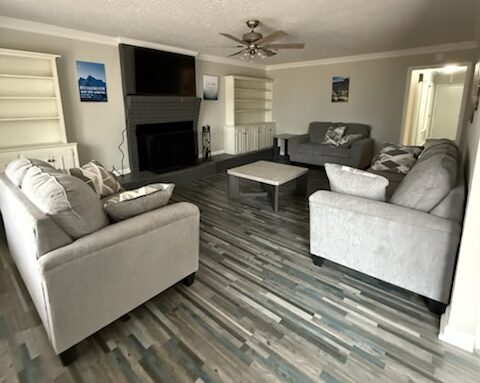
Higher Power Sober Living
Real accountability, real structure — with live-in support, every step of the way
Welcome to Higher Power Sober Living — where recovery meets real life.
We provide more than just a place to stay; we offer a safe, structured, and supportive home where individuals in recovery can rebuild their lives with dignity and purpose. Whether you’re fresh out of treatment or simply seeking a solid foundation for long-term sobriety, our program is designed to walk with you — one day at a time — as you grow, heal, and rediscover your strength. Here, you’re not alone. You’re part of a community that understands the journey and believes in your future.
Why Choose a Sober Living Program?
A Safe, Supportive Step Toward Lifelong Recovery
At Higher Power Sober Living, we believe that recovery is more than just quitting drugs or alcohol — it's about rebuilding your life with purpose, community, and confidence. Our sober living program bridges the gap between treatment and independent living, offering structure, support, and stability when it’s needed most.
The Benefits of Sober Living
🛏️ A Drug- and Alcohol-Free Environment
Our homes provide a clean, safe space where residents can focus fully on their recovery — free from the triggers and temptations of the outside world.
🤝 Built-In Support & Accountability
You’re not doing this alone. Living with others who are also committed to sobriety fosters real connection, encouragement, and daily accountability.
🕒 Structure That Builds Healthy Habits
Daily routines, curfews, regular drug testing, and shared responsibilities create the kind of structure that supports long-term success.
🧠 Real-Life Skills for Real-World Living
We help residents gain confidence through essential life skills — from budgeting and job searching to stress management and healthy communication.
🌱 A Bridge to Independence
Sober living is the next step after treatment — a place where you can gradually transition back into work, school, or family life while still having support.
Why Sober Living Works
Unlike going straight from rehab to everyday life, sober living gives you time to adjust, grow, and build a solid foundation for lasting recovery. Studies show that individuals who spend time in sober living environments experience lower relapse rates, greater stability, and stronger life outcomes.
Ready to Start Fresh?
If you're looking for a supportive community that encourages growth, responsibility, and real transformation — Higher Power Sober Living is here for you. Your next chapter starts now.
Why Medication-Assisted Treatment (MAT) Is So Important
Medication-Assisted Treatment (MAT) is a powerful, evidence-based approach to overcoming opioid and alcohol use disorders. It combines FDA-approved medications with counseling and behavioral therapies, offering a whole-person strategy to recovery.
MAT significantly increases the chances of long-term recovery. By reducing cravings and withdrawal symptoms, individuals can focus more on healing, building life skills, and maintaining sobriety.
One of the biggest dangers in early recovery is relapse, which often leads to overdose. MAT helps stabilize brain chemistry and minimize the risk of a return to use—making recovery safer and more sustainable.
By reducing the physical and psychological rollercoaster of addiction, MAT helps individuals return to work, rebuild relationships, and participate in everyday life without constant struggle.
MAT is endorsed by organizations like the Substance Abuse and Mental Health Services Administration (SAMHSA) and the National Institute on Drug Abuse (NIDA). It’s not a “replacement” addiction—it’s a medically supported path to freedom.
Every person’s recovery journey is different. MAT can be tailored to meet individual needs, providing both structure and flexibility. It’s not a one-size-fits-all program—it’s a personalized tool for hope and healing.
What to look for in a Sober Living Facility
Your guide to finding a safe, supportive, and structured place to continue your recovery journey.
- 1. Structured Environment
Look for clear house rules, curfews, and expectations. A good program encourages personal responsibility and healthy routines. - 2. On-Site House Management
Facilities with live-in management offer 24/7 support and accountability. Staff should be trained, approachable, and recovery-minded. - 3. Drug & Alcohol Testing
Regular, random testing helps maintain a sober and safe environment for everyone involved. - 4. Peer Support & Community
Connection is key in recovery. Look for a home that promotes mutual support, respect, and peer engagement through meetings and shared responsibilities. - 5. Clean, Safe Living Conditions
Homes should be well-kept and located in a safe area. Cleanliness and comfort promote dignity and peace of mind during recovery. - 6. Clear Expectations & Guidelines
A quality home has clear policies on behavior, chores, curfews, and consequences — creating consistency and trust. - 7. Life Skills & Personal Growth Support
Choose homes that help residents with job readiness, budgeting, and building healthy coping skills — essential for long-term independence. - 8. Strong Accountability Systems
Daily check-ins, mentorship, and tracking progress help residents stay on course and reduce relapse risk. - 9. Flexible Length of Stay
Recovery is not one-size-fits-all. Look for programs that allow flexible stays based on your personal growth and readiness. - 10. Trusted Reputation
Research reviews, ask around, and trust your instincts. A strong sober living home will have a proven record of resident success.
Bonus Tip:
Tour the facility if you can. Meet the staff, observe the home’s environment, and ask questions. Trust how you feel — your recovery deserves the right fit.
we offer local medical and therapy resources
- Local intensive out patient
- Individual therapy
- Medication maintenance
- “MAT” Medication assisted treatment doctor
How Do Sober Living Houses Work?
A sober living house is a safe, structured environment where people in recovery live together and support one another as they transition back into everyday life after treatment. It’s not a rehab or clinic — it’s a vital step between treatment and full independence.
🔑 1. Drug- and Alcohol-Free Environment
Residents commit to total abstinence. Random drug and alcohol testing ensures a clean, accountable living space for everyone.
🕒 2. Daily Structure & Routine
Most houses operate on a daily schedule, including curfews, chores, and house meetings — helping rebuild healthy habits and life discipline.
👥 3. Shared Living with Peer Support
Recovery thrives in community. Living with others in recovery builds a foundation of connection, shared experience, and mutual accountability.
🧭 4. On-Site or Live-In Management
Many homes have live-in house managers who maintain structure, provide support, and help residents stay on track.
📋 5. House Rules & Responsibilities
Every resident follows established house rules — including no substance use, curfews, meeting attendance, and household chores. Accountability is key to keeping the environment safe and supportive.
💼 6. Focus on Independence
Residents are encouraged to work, attend school, or volunteer as part of their return to independent living — all while having support close by.
🛑 7. Relapse Prevention & Continued Support
By offering routine, structure, and peer accountability, sober living homes help residents reduce relapse risk and stay connected to recovery resources.
✅ Who Is Sober Living For?
Sober living is ideal for individuals who:
- ✔️ Have completed a detox or treatment program
- ✔️ Are committed to sobriety but need extra support
- ✔️ Want structure, accountability, and community
- ✔️ Don’t have a safe or sober home environment to return to
Sober living isn’t the end of the journey — it’s the launchpad for lasting recovery.
Employment opportunities
We actively collaborate with local business owners and community partners to create meaningful employment opportunities for our residents, supporting both their professional development and successful reintegration into the workforce.
A Typical Day at a Sober Living House
Daily structure provides the foundation for long-term sobriety and personal growth.
🌅 Morning Routine
Most houses start the day early — typically between 6:00 AM and 8:00 AM. Residents are expected to get up, make their beds, clean up their areas, and start the day with intention. Many homes encourage practices like morning meditation, journaling, or a house check-in to begin the day focused and centered.
🍳 Breakfast & Chores
Each resident prepares their own breakfast. Assigned daily or weekly chores (like cleaning shared spaces or taking out trash) promote a sense of pride and responsibility in the home.
💼 Work, School, or Volunteer Time
During the day, residents are expected to be productive and goal-focused. This may include:
- ✔️ Attending work or school
- ✔️ Participating in outpatient programs or therapy
- ✔️ Volunteering or giving back to the community
- ✔️ Job searching or building life skills
Staying active helps rebuild a lifestyle of purpose and independence.
🤝 Recovery Meetings & Check-ins
Most sober living homes require regular attendance at 12-step meetings (like AA or NA), group therapy, or peer-led recovery groups. Some homes host in-house meetings or nightly check-ins to support ongoing accountability.
🍽️ Evening Routine
Residents usually return by dinner time. Evenings are a time to reflect, relax, and connect. This often includes:
- ✔️ Making or sharing dinner
- ✔️ Attending a meeting or in-house session
- ✔️ Journaling or quiet time
- ✔️ Social time with housemates
Curfews are enforced to help maintain a healthy and structured environment.
😴 Lights Out
Quiet hours typically begin around 10:00–11:00 PM. A regular sleep schedule supports physical health, emotional balance, and recovery progress.
🌱 A Healthy Balance of Structure and Freedom
Life in a sober living home is designed to feel like real life — with the added benefit of community, accountability, and ongoing support. It’s about building habits that lead to long-term success.
Gender Specific Housing
We offer comfortable and supportive housing options for both men and women, providing gender-specific living environments that promote safety, accountability, and community. Each home is designed to foster a structured and respectful atmosphere where residents can focus on their recovery and personal growth.
Follow us on social media
Easy Navigation




Why Choose a Sober Living Program?
A Safe, Supportive Step Toward Lifelong Recovery
At Higher Power Sober Living, we believe that recovery is more than just quitting drugs or alcohol — it's about rebuilding your life with purpose, community, and confidence. Our sober living program bridges the gap between treatment and independent living, offering structure, support, and stability when it’s needed most.
The Benefits of Sober Living
🛏️ A Drug- and Alcohol-Free Environment
Our homes provide a clean, safe space where residents can focus fully on their recovery — free from the triggers and temptations of the outside world.
🤝 Built-In Support & Accountability
You’re not doing this alone. Living with others who are also committed to sobriety fosters real connection, encouragement, and daily accountability.
🕒 Structure That Builds Healthy Habits
Daily routines, curfews, regular drug testing, and shared responsibilities create the kind of structure that supports long-term success.
🧠 Real-Life Skills for Real-World Living
We help residents gain confidence through essential life skills — from budgeting and job searching to stress management and healthy communication.
🌱 A Bridge to Independence
Sober living is the next step after treatment — a place where you can gradually transition back into work, school, or family life while still having support.
Why Sober Living Works
Unlike going straight from rehab to everyday life, sober living gives you time to adjust, grow, and build a solid foundation for lasting recovery. Studies show that individuals who spend time in sober living environments experience lower relapse rates, greater stability, and stronger life outcomes.
Ready to Start Fresh?
If you're looking for a supportive community that encourages growth, responsibility, and real transformation — Higher Power Sober Living is here for you. Your next chapter starts now.
What to look for in a Sober Living Facility
Your guide to finding a safe, supportive, and structured place to continue your recovery journey.
- 1. Structured Environment
Look for clear house rules, curfews, and expectations. A good program encourages personal responsibility and healthy routines. - 2. On-Site House Management
Facilities with live-in management offer 24/7 support and accountability. Staff should be trained, approachable, and recovery-minded. - 3. Drug & Alcohol Testing
Regular, random testing helps maintain a sober and safe environment for everyone involved. - 4. Peer Support & Community
Connection is key in recovery. Look for a home that promotes mutual support, respect, and peer engagement through meetings and shared responsibilities. - 5. Clean, Safe Living Conditions
Homes should be well-kept and located in a safe area. Cleanliness and comfort promote dignity and peace of mind during recovery. - 6. Clear Expectations & Guidelines
A quality home has clear policies on behavior, chores, curfews, and consequences — creating consistency and trust. - 7. Life Skills & Personal Growth Support
Choose homes that help residents with job readiness, budgeting, and building healthy coping skills — essential for long-term independence. - 8. Strong Accountability Systems
Daily check-ins, mentorship, and tracking progress help residents stay on course and reduce relapse risk. - 9. Flexible Length of Stay
Recovery is not one-size-fits-all. Look for programs that allow flexible stays based on your personal growth and readiness. - 10. Trusted Reputation
Research reviews, ask around, and trust your instincts. A strong sober living home will have a proven record of resident success.
Bonus Tip:
Tour the facility if you can. Meet the staff, observe the home’s environment, and ask questions. Trust how you feel — your recovery deserves the right fit.
How Do Sober Living Houses Work?
A sober living house is a safe, structured environment where people in recovery live together and support one another as they transition back into everyday life after treatment. It’s not a rehab or clinic — it’s a vital step between treatment and full independence.
🔑 1. Drug- and Alcohol-Free Environment
Residents commit to total abstinence. Random drug and alcohol testing ensures a clean, accountable living space for everyone.
🕒 2. Daily Structure & Routine
Most houses operate on a daily schedule, including curfews, chores, and house meetings — helping rebuild healthy habits and life discipline.
👥 3. Shared Living with Peer Support
Recovery thrives in community. Living with others in recovery builds a foundation of connection, shared experience, and mutual accountability.
🧭 4. On-Site or Live-In Management
Many homes have live-in house managers who maintain structure, provide support, and help residents stay on track.
📋 5. House Rules & Responsibilities
Every resident follows established house rules — including no substance use, curfews, meeting attendance, and household chores. Accountability is key to keeping the environment safe and supportive.
💼 6. Focus on Independence
Residents are encouraged to work, attend school, or volunteer as part of their return to independent living — all while having support close by.
🛑 7. Relapse Prevention & Continued Support
By offering routine, structure, and peer accountability, sober living homes help residents reduce relapse risk and stay connected to recovery resources.
✅ Who Is Sober Living For?
Sober living is ideal for individuals who:
- ✔️ Have completed a detox or treatment program
- ✔️ Are committed to sobriety but need extra support
- ✔️ Want structure, accountability, and community
- ✔️ Don’t have a safe or sober home environment to return to
Sober living isn’t the end of the journey — it’s the launchpad for lasting recovery.
A Typical Day at a Sober Living House
Daily structure provides the foundation for long-term sobriety and personal growth.
🌅 Morning Routine
Most houses start the day early — typically between 6:00 AM and 8:00 AM. Residents are expected to get up, make their beds, clean up their areas, and start the day with intention. Many homes encourage practices like morning meditation, journaling, or a house check-in to begin the day focused and centered.
🍳 Breakfast & Chores
Each resident prepares their own breakfast. Assigned daily or weekly chores (like cleaning shared spaces or taking out trash) promote a sense of pride and responsibility in the home.
💼 Work, School, or Volunteer Time
During the day, residents are expected to be productive and goal-focused. This may include:
- ✔️ Attending work or school
- ✔️ Participating in outpatient programs or therapy
- ✔️ Volunteering or giving back to the community
- ✔️ Job searching or building life skills
Staying active helps rebuild a lifestyle of purpose and independence.
🤝 Recovery Meetings & Check-ins
Most sober living homes require regular attendance at 12-step meetings (like AA or NA), group therapy, or peer-led recovery groups. Some homes host in-house meetings or nightly check-ins to support ongoing accountability.
🍽️ Evening Routine
Residents usually return by dinner time. Evenings are a time to reflect, relax, and connect. This often includes:
- ✔️ Making or sharing dinner
- ✔️ Attending a meeting or in-house session
- ✔️ Journaling or quiet time
- ✔️ Social time with housemates
Curfews are enforced to help maintain a healthy and structured environment.
😴 Lights Out
Quiet hours typically begin around 10:00–11:00 PM. A regular sleep schedule supports physical health, emotional balance, and recovery progress.
🌱 A Healthy Balance of Structure and Freedom
Life in a sober living home is designed to feel like real life — with the added benefit of community, accountability, and ongoing support. It’s about building habits that lead to long-term success.
Follow us on social media
Easy Navigation



